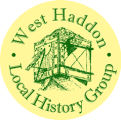The wool trade goes north and West Haddon begins to build.
The most eventful time in West Haddon’s history must have been the century which saw the rise and decline of its textile industry and the total transformation of farming in the village.
The wool trade built up through the early 1700’s and was boosted by the turnpike road around 1740, but by 1780 the factory system, and more particularly the Yorkshire woollen mills, were dominating the industry. Hardly any West Haddon weavers or woolcombers survived into the nineteenth century.
In the middle of all this, in 1765, the old medieval open fields were enclosed, giving the landscape we know today. Now many of the small independent cottage craftsmen were no longer able to supplement their income with the produce from common grazing, or supply themselves with winter fuel from West Haddon Heath. Many more of these with just an acre or two of their own found it made more economic sense to rent it out to a larger farmer for a cash rent, or to sell it outright and set up in London or elsewhere where the market was larger.
Thus, after enclosure, farms became bigger, farmers became wealthier and they spent much of their wealth on their houses. This led to an increase in prosperity amongst the builders and brickmakers, masons, and carpenters of the village, and a new animal appeared on the scene – the speculative builder.
When Edward Kirtland married his second wife in the 1680s he settled his old house in High Street on his only son, and in return for the dowry his wife Elizabeth brought to him he built her an imposing new house in West End, with extensive outbuildings and gardens, in which to bring up a second family (Oak House). A century later, when Thomas Patch was married for the first time in 1790, his father settled him a house with a paddock attached, and his bride, Mary West, brought him the cottage she had inherited from her grandfather. IN 1821 he did a good deal with John Johnson, a builder, who saw that there was good clay in the paddock and wanted to use it as a brickyard. Mortgaging the property he already had to finance the new building, by 1827 Thomas Patch had transformed his house and paddock into 13 houses and cottages. We had originally believed these to be the block of West End from Shepherd’s Row to the Green, but a bundle of deeds has come to light which point to the end to the end of Guilsborough Road as a more likely site for mR Patch’s operations. The waste ground on the south side of the road may well be what is left of the brickyard (in fact this site has been developed for housing and is called The Old Brickyard).
